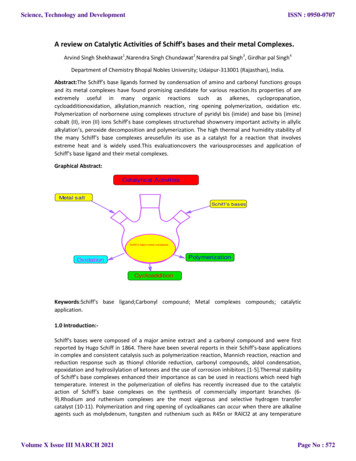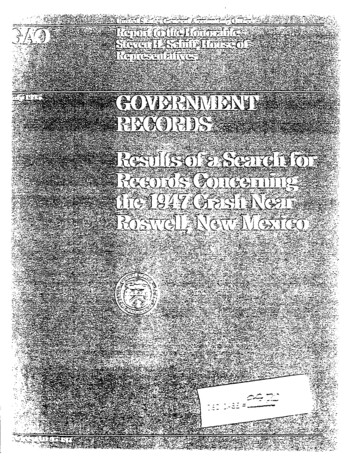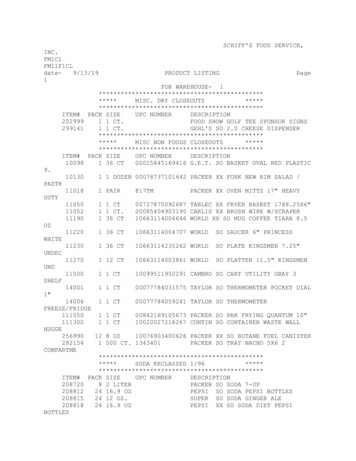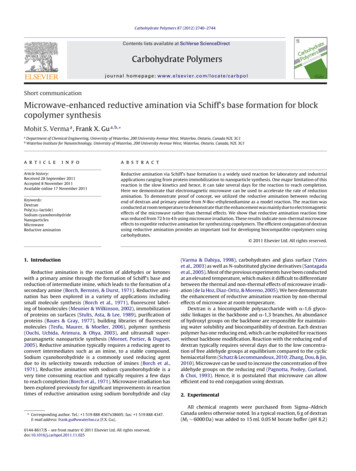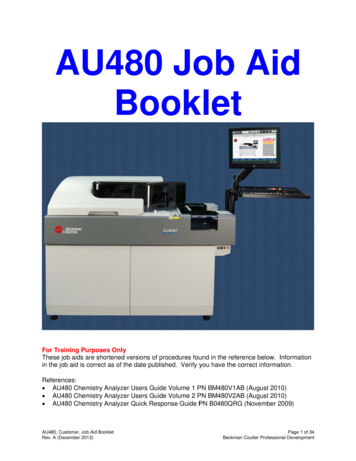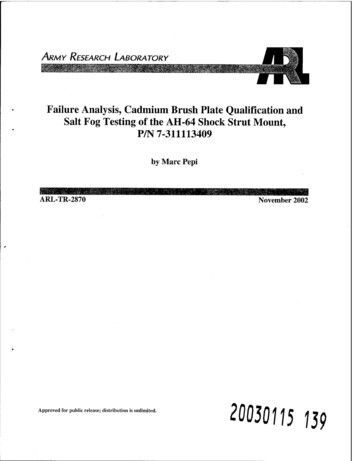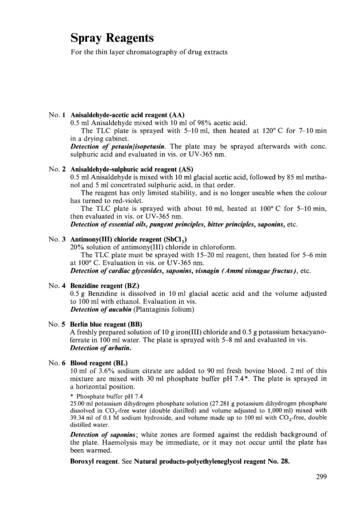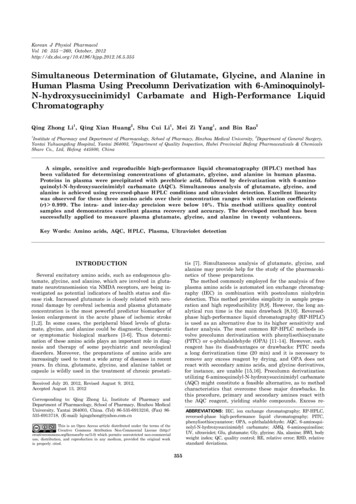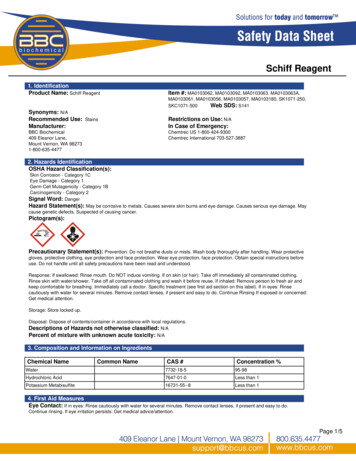
Transcription
Schiff Reagent1. IdentificationProduct Name: Schiff ReagentItem #: MA0103062, MA0103092, MA0103063, MA0103063A.MA0103061, MA0103056, MA0103057, MA0103180, SK1071-250,SKC1071-500Web SDS: S141Synonyms: N/ARecommended Use: StainsManufacturer:BBC Biochemical409 Eleanor Lane,Mount Vernon, WA 982731-800-635-4477Restrictions on Use: N/AIn Case of Emergency:Chemtrec US 1-800-424-9300Chemtrec International 703-527-38872. Hazards IdentificationOSHA Hazard Classification(s):Skin Corrosion - Category 1CEye Damage - Category 1Germ Cell Mutagenicity - Category 1BCarcinogenicity - Category 2Signal Word: DangerHazard Statement(s): May be corrosive to metals. Causes severe skin burns and eye damage. Causes serious eye damage. Maycause genetic defects. Suspected of causing cancer.Pictogram(s):Precautionary Statement(s): Prevention: Do not breathe dusts or mists. Wash body thoroughly after handling. Wear protectivegloves, protective clothing, eye protection and face protection. Wear eye protection, face protection. Obtain special instructions beforeuse. Do not handle until all safety precautions have been read and understood.Response: If swallowed: Rinse mouth. Do NOT induce vomiting. If on skin (or hair): Take off immediately all contaminated clothing.Rinse skin with water/shower. Take off all contaminated clothing and wash it before reuse. If inhaled: Remove person to fresh air andkeep comfortable for breathing. Immediately call a doctor. Specific treatment (see first aid section on this label). If in eyes: Rinsecautiously with water for several minutes. Remove contact lenses, if present and easy to do. Continue Rinsing If exposed or concerned:Get medical attention.Storage: Store locked up.Disposal: Dispose of contents/container in accordance with local regulations.Descriptions of Hazards not otherwise classified: N/APercent of mixture with unknown acute toxicity: N/A3. Composition and Information on IngredientsChemical NameCommon NameCAS #Concentration %Water7732-18-595-98Hydrochloric Acid7647-01-0Less than 1Potassium Metabisulfite16731-55--8Less than 14. First Aid MeasuresEye Contact: If in eyes: Rinse cautiously with water for several minutes. Remove contact lenses, if present and easy to do.Continue rinsing. If eye irritation persists: Get medical advice/attention.Page 1/5
Schiff ReagentSkin Contact: If on skin (or hair): Take off immediately all contaminated clothing and wash before reuse. Wash with plenty of water.If skin irritation occurs: Get medical advice/attention.Inhalation: Remove to fresh air; give artificial respiration if breathing has stopped. Get medical advice/attention if you feel unwell.Ingestion: Do not induce vomiting. If vomiting occurs spontaneously, keep head below hips to prevent aspiration of liquid into thelungs. Get medical attention.Symptoms: Irritation eyes, nose, throat; headache, dizzinessRecommendations for immediate medical care/special treatment: Get medical advice/attention if you feel unwell.5. Fire- Fighting MeasuresExtinguishing Media: Dry chemical, carbon dioxide, alcohol foam, water.Fire Hazards (Chemical): Not flammable.Special Protective Equipment: Fire fighters should use self-contained breathing apparatus and protective clothing.Precautions for Firefighters: Carbon monoxide and unidentified organic compounds may be formed during combustion.6. Accidental Release MeasuresEmergency Procedures: Evacuate the area of all unnecessary personnel. Wear suitable protective equipment. Eliminate allsources of ignition and provide ventilation.Protective Equipment: See section 8Environmental Precautions: Prevent release to the environment by using barriers.Containment and Clean-Up Procedures: Use barriers to prevent spreading. Collect spill in container. Call waste authorities.7. Handling and StorageHandling: Do not breathe vapors. Do not eat, drink or smoke when using this product.Storage: Store locked up. Store in dark container in refrigerator. Keep lid tightly closed. Keep out of sunlight.8. Exposure Controls/Personal ProtectionOSHA Permissible Exposure Limits (PELs):ReagentCAS #Hydrochloric Acid7647-01-0OSHA PEL TWA5 ppm (7 mg/m3) CeilingACGIH Threshold Limit Values (TLVs):ReagentHydrochloric AcidCAS #7647-01-0ACGIH PEL TLVACGIH STEL2 ppm (3 mg/m3) CeilingEngineering Controls: Use in a well ventilated area to prevent exposure. Maintain eyewash fountain and quick-drench facilities inwork areas.Personal Protective Measures: Wear gloves, lab coat, eye protection and impervious footwear. Contact lenses should not beworn when working with this material.Special PPE Requirements: If ventilation hood not available wear respirator.9. Physical and Chemical Properties SectionAppearance: Colorless, LiquidMolecular Weight: N/AMolecular Formula: N/ApH: N/ABoiling Point and Boiling Range: 100ºCMelting Point/Freezing Point: N/AFlash Point: N/ASpecific Gravity/Relative Density: N/APage 2/5
Schiff ReagentOdor: Pungent odorOdor Threshold: N/AColor: ColorlessFlammability (solid/gas): N/AVapor Density: N/AUpper/Lower flammability or explosive limits: N/AVapor Pressure: N/AEvaporation Rate: N/APartition Coefficient: n-octanol/water: N/AViscosity: N/AAuto-ignition temperature: N/ASolubility: Soluble in water.Decomposition Temperature: N/A10. Stability and ReactivityReactivity:Chemical Stability: StableConditions of Stability/Instability: Stable under normal conditions of temperature and pressure.Stabilizers needed: NoneSafety issue indicated by appearance change: N/AOther: N/AHazardous Reactions: N/AHazardous Polymerization: Does not occurConditions to avoid: N/AClasses of Incompatible Materials: Oxidizers, Strong Acids, Strong BasesHazardous Decomposition Products: Thermal-oxidation degradation can produce oxides of carbon. Toxic gases and vapors(I.e. Carbon monoxide) may be released in a fire. Hydrogen chloride gas, sodium/sodium oxides, nitrogen oxides, sulfur oxides.11. Toxicological InformationLikely Routes of ExposureEyes: Corrosive to eyes, may cause permanent damage. Irritation with redness, pain and possible corneal damage.Skin: Corrosive to skin, may cause irritation or permanent damage with redness and pain.Inhalation: May cause irritation of the mucous membranes with sore throat and coughing. Repeat exposure may affect selectorgans, increase risk ofgerm cell mutagenicity and risk of cancer.Ingestion: Toxic by ingestion, consult a physician. Possible damage to gastrointestinal tract and diarrhea.Signs or Symptoms of Exposure: Nausea. Cancer, germ cell mutagenicity, damage to organs.Effects from short term exposure (delayed, immediate, chronic): Irritation to the eyes, nose, throat; headache,dizziness, nausea.Acute Toxicity (Numerical Measures): Hydrochloric Acid: LD50(oral, rat) 900 mg/kg; LC50(inhalation, mouse) 1108ppm/1H; LC50(inhalation, mouse) 3940 mg/m3/30M.Carcinogenicity (NTP, IARC, OSHA): Contains Basic Fuchsin CAS 569-61-9: IARC Group 2B, possibly carcinogenic tohumans12. Ecological InformationEcotoxicity: Ecotoxicity: CAS 7647-01-0 Hydrochloric Acid Fish: LC50 (96 Hr) Mosquito Fish: 282 mg/L LC100(24Hr) Trout: 10mg/L. Invertebrates: LC50(48Hr) Starfish: 100-330 mg/L LC50 (48Hr) Shrimp: 100-330 mg/LPersistence and degradability: N/ABioaccumulation Potential (octanol-water partition coefficient, BCF): N/AMobility in the soil: N/APage 3/5
Schiff ReagentAdverse Environmental Effects: N/A13. Disposal ConsiderationsRecommended Disposal Containers: Check with your local waste authorities*Recommended Disposal Methods: Do not dispose of in drains, check with your local waste authorities.*Physical/Chemical Properties affecting Disposal: See section 2 and section 9 applicable information.*Special Precautions for Landfill and Incineration Activities: Check with your local waste authorities.*Waste Stream: Consult your local or regional authorities.*14. Transport InformationUN Number: Not regulated.UN Proper Shipping Name:Transport Hazard Class(es):Packing Group Number:Environmental Hazards (IMDG code):Marine Pollutant:Transport in Bulk (IBC Code):Special Transport Precautions:15. Regulatory InformationOSHA: N/ADOT: N/AEPA: N/ACPSC: N/APage 4/5
Schiff Reagent16. Other InformationRevision Date: 06/05/2018NFPAHealth2Fire Hazard0Reactivity0National Fire Protection Association (USA) NFPAFire Hazard0Health20ReactivitySpecific HazardSpecific HazardHMISHealthFlammabilityPhysical HazardPersonal Protection200Hazardous Material Information System HMISHealth2Flammability0Physical Hazard0Personal ProtectionNotice to Reader:To the best of our knowledge, the information contained herein is accurate. However, neither the above named supplier nor any of itssubsidiaries assumes any liability whatsoever for the accuracy or completeness of the information contained herein.Page 5/5Powered by TCPDF (www.tcpdf.org)
Schiff Reagent Skin Contact: If on skin (or hair): Take off immediately all contaminated clothing and wash before reuse.Wash with plenty of water. If skin irritation occurs: Get medical advice/attention. Inhalation: Remove to fresh air; give artificial respiration if breathing has stopped.Get medical advice/attention if you feel unwell.
